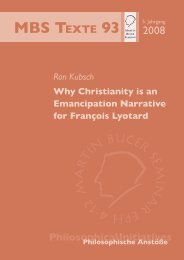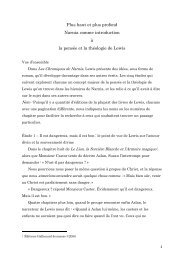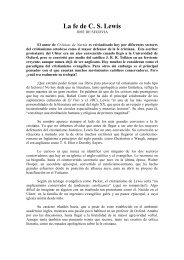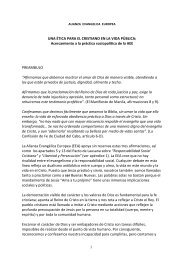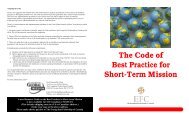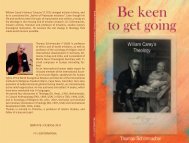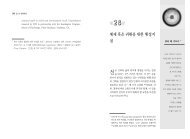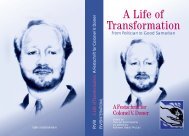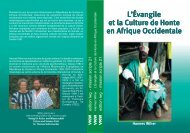Calvin and Missions - World Evangelical Alliance
Calvin and Missions - World Evangelical Alliance
Calvin and Missions - World Evangelical Alliance
You also want an ePaper? Increase the reach of your titles
YUMPU automatically turns print PDFs into web optimized ePapers that Google loves.
Nicholls: The Theology of William Carey (1993) 133<br />
level of spirituality in his churches, laid the foundation of his Churchcentred<br />
underst<strong>and</strong>ing of mission. Here too he was influenced by his<br />
friends John Ryl<strong>and</strong>, Andrew Fuller <strong>and</strong> John Sutcliff. It was to be expected<br />
that the missionary structure Carey pioneered was a denominational<br />
one.<br />
Carey’s Doctrine of the Church followed the ‘primitive’ New Testament<br />
model which stressed preaching, spontaneous spirituality in worship, emphasis<br />
on fellowship, the ordinances of believers’ baptism <strong>and</strong> on the<br />
Lord’s Supper <strong>and</strong> on independency in church organization. 198 Carey carried<br />
this model to India. It is significant that with the arrival of the new<br />
missionaries in Serampore early in the year 1800, Carey <strong>and</strong> his colleagues<br />
immediately constituted themselves as the local Baptist Church <strong>and</strong> elected<br />
Carey as pastor. The first convert, Krishna Pal, upon his baptism in December<br />
1800, was admitted without delay to the membership of this church<br />
<strong>and</strong> invited to participate in the service of the Lord’s Supper. Thus the concept<br />
of the gathered church with its emphasis on the fellowship of believers<br />
became the guiding principle of Carey’s evangelistic <strong>and</strong> church planting<br />
ministries.<br />
Carey <strong>and</strong> his colleagues carried this principle into the structuring of the<br />
Serampore Mission. As a community they covenanted together to live as<br />
an extended family, sharing in a common table, common purse <strong>and</strong> in rotating<br />
leadership. Carey had been inspired to follow this joint family lifestyle<br />
by the example of the Moravian missionaries, except in the concept of<br />
a permanent house father. In October 1805 they drew up a ‘Form of<br />
Agreement’ in which in eleven points they outlined their Mission strategy.<br />
This included the resolution that the church must be indigenous from the<br />
beginning. The 8th principle stated: ‘it is only by means of native preachers<br />
that we can hope for the universal spread of the Gospel throughout this<br />
immense continent. We think it is our duty as soon as possible, to advise<br />
the native brethren who may be formed into separate churches, to choose<br />
their pastors <strong>and</strong> deacons from their own countrymen.’ 199<br />
It was often stated that Carey failed as an evangelist <strong>and</strong> in establishing<br />
new churches. John Mack of Serampore College, in a funeral sermon on<br />
198 Christopher Smith contrasts the ‘primitive’ model with the ‘professional’ institutional<br />
model of the later church. He argues that the Serampore trio operated simultaneously<br />
in the spiritual world of personal piety <strong>and</strong> the commercial world of<br />
technologically-impressive capitalism. See his article ‘A Tale of Many Models’,<br />
International Bulletin of Missionary Research 1992.<br />
199 Cited Christian History (Vol. XI. No. 4) p. 34.




